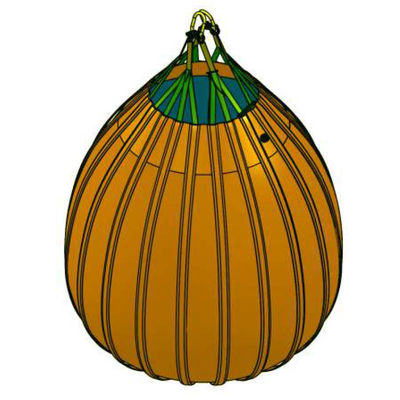Inflatable Boat Rubber Ship Marine Airbag Resistant To Corrosion
Description
Marine air bags are designed for the lifting and positioning of large, submerged objects, including vessels, platforms, and machinery. The bags are widely used in marine salvage operations, harbor construction, and offshore oil and gas projects. Constructed with reinforced PVC material and heavy-duty straps, they offer both resilience and reliability in harsh marine environments. The bags are equipped with manual and automatic inflation valves, providing control over ascent speed and buoyancy adjustments. When operating marine air bags, it’s important to always inspect for signs of wear before use and avoid overloading the bag beyond its rated buoyancy capacity. Packaging is designed for secure transit, and shipping times depend on order size and location. We accept bank transfers and letters of credit as payment methods, ensuring smooth transactions. For warranty claims, please contact our support team for assistance with product repairs or replacements.

Specifications
| Product Name |
Marine Air Bag |
| Material |
100% High Tensile NR |
| Dimensions |
Diameter 0.5m - 3.0m,
Length 3.0m - 28.0m,
or as Request
|
| Working Pressure |
0.05-0.25MPA |
| Technology |
Overall Winding, High Pressure, Explosion-proof |
| Metal Parts |
Q355 / SS304 / SS316 |
| OEM |
Supported |
| MOQ |
1 |
| Repair Tools |
Electric Heating Plate, Repair Materials, Glue, Free of Charge |
| Standard |
ISO14409:2011 |
| Certificate |
ABS, BV, KR, LR, GL, NK, RINA, DNV, RMRS |
| Package |
Pallets, Wooden Cases |
| Service Life |
20 Years |
| Warranty |
36 Months |
| Diameter |
Working
Pressure
|
Working
Height
|
Bearing Capacity |
| KN/m |
Ton/m |
| D=1.0m |
0.14Mpa |
0.6m |
87.96 |
8.98 |
| 0.5m |
109.96 |
11.22 |
| 0.4m |
131.95 |
13.46 |
| D=1.2m |
0.12Mpa |
0.7m |
94.25 |
9.62 |
| 0.6m |
113.10 |
11.54 |
| 0.5m |
131.95 |
13.46 |
| 0.4m |
150.80 |
15.39 |
| D=1.5m |
0.10Mpa |
0.9m |
94.25 |
9.62 |
| 0.8m |
109.96 |
11.22 |
| 0.7m |
125.66 |
12.82 |
| 0.6m |
141.37 |
14.43 |
| 0.5m |
157.08 |
16.03 |
| D=1.8m |
0.09Mpa |
1.1m |
98.96 |
10.10 |
| 1.0m |
113.10 |
11.54 |
| 0.9m |
127.33 |
12.98 |
| 0.8m |
141.37 |
14.43 |
| 0.7m |
155.51 |
15.87 |
| 0.6m |
169.65 |
17.31 |
| D=2.0m |
0.08Mpa |
1.2m |
100.53 |
10.26 |
| 1.1m |
113.10 |
11.54 |
| 1.0m |
125.66 |
12.82 |
| 0.9m |
138.23 |
14.11 |
| 0.8m |
150.80 |
15.39 |
| 0.7m |
163.36 |
16.67 |
| 0.6m |
175.93 |
17.95 |
| * Other size can be provided follow client's requirements. |
Features
Overpressure Relief Valves
Marine air bags come with overpressure relief valves to ensure safe and controlled inflation, preventing damage to the bag during lifting operations.
Multiple Inflation and Deflation Ports
Equipped with multiple inflation and deflation ports, marine air bags allow for quick and efficient air flow control, providing fine-tuned buoyancy adjustments.
Reinforced Lifting Points
These air bags feature reinforced lifting straps or lifting points, ensuring secure attachment to the object being lifted for optimal performance and safety.
Heavy Duty Load Capacity
Designed to support substantial loads, marine air bags are capable of lifting heavy objects—from industrial equipment to sunken vessels with ease.
Applications
● Ship launching and dry docking
● Pipeline lifting and positioning
● Offshore oil rig decommissioning
● Subsea cable laying and installation
● Underwater structural positioning
Advantages
Rigorous Quality Control
Every Marine Air Bag undergoes thorough quality checks throughout the manufacturing process, ensuring compliance with international standards.
Strong Research and Development
Our commitment to innovation drives ongoing research and development, leading to continuous improvements in product performance and reliability.
Expert Consultation Services
We offer professional consultations to guide clients in selecting the right products for their specific applications, ensuring optimal use of our air bags.
Comprehensive Testing Procedures
Our air bags are subjected to extensive testing, including load tests and durability assessments, to guarantee their effectiveness and safety.


FAQ
1. What happens if my Marine Air Bag becomes overinflated?
If the Marine Air Bag is overinflated, the overpressure relief valve will release air to prevent damage.
2. How do I choose the right Marine Air Bag for my project?
Our experts will assist you in selecting the appropriate size and capacity based on the weight and dimensions of the object to be lifted.
3. Can I rent Marine Air Bags instead of purchasing them?
Yes, we offer rental options for Marine Air Bags based on your project’s duration and requirements.
4. Are Marine Air Bags environmentally friendly?
Yes, Marine Air Bags are made with non-toxic, environmentally safe materials, ensuring they don't harm marine ecosystems.

 Your message must be between 20-3,000 characters!
Your message must be between 20-3,000 characters! Please check your E-mail!
Please check your E-mail!  Your message must be between 20-3,000 characters!
Your message must be between 20-3,000 characters! Please check your E-mail!
Please check your E-mail! 














